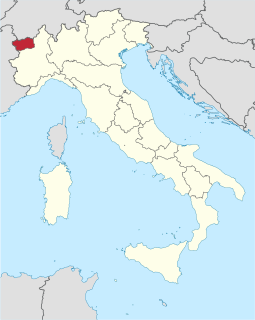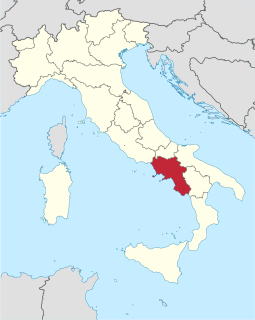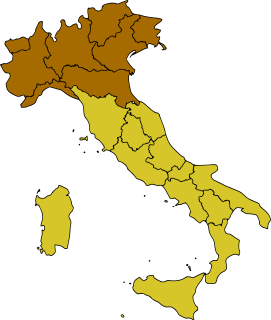 W
WThe regions of Italy are the first-level constituent entities of the Italian Republic, constituting its second NUTS administrative level. There are 20 regions, of which five have a broader amount of autonomy than the other 15 regions. Under the Italian Constitution, each region is an autonomous entity with defined powers. With the exception of the Aosta Valley, each region is divided into a number of provinces.
 W
WAbruzzo or Abruzzi is a region of Southern Italy with an area of 10,763 square km and a population of 1.3 million. It is divided into four provinces: L'Aquila, Teramo, Pescara, and Chieti. Its western border lies 80 km (50 mi) east of Rome. Abruzzo borders the region of Marche to the north, Lazio to the west and south-west, Molise to the south-east, and the Adriatic Sea to the east. Geographically, Abruzzo is divided into a mountainous area in the west, which includes the Gran Sasso d'Italia, and a coastal area in the east with beaches on the Adriatic Sea.
 W
WThe Aosta Valley is a mountainous autonomous region in northwestern Italy. It is bordered by Auvergne-Rhône-Alpes, France, to the west, Valais, Switzerland, to the north, and by Piedmont, Italy, to the south and east. The regional capital is Aosta.
 W
WApulia is a region of Italy, located in the southern peninsular section of the country, bordering the Adriatic Sea to the east, the Ionian Sea to the southeast, and the Strait of Otranto and Gulf of Taranto to the south. The region comprises 19,345 square kilometers (7,469 sq mi), and its population is about four million.
 W
WBasilicata, also known by its ancient name Lucania, is an administrative region in Southern Italy, bordering on Campania to the west, Apulia to the north and east, and Calabria to the south. It has two coastlines: a 30-km stretch on the Tyrrhenian Sea between Campania and Calabria, and a longer coastline along the Gulf of Taranto between Calabria and Apulia. The region can be thought of as the "instep" of Italy, with Calabria functioning as the "toe" and Apulia the "heel".
 W
WCalabria, known in antiquity as Bruttium, is a region in Southern Italy.
 W
WCampania is an administrative region of Italy. Located on the south-western portion of the Italian Peninsula, with the Tyrrhenian Sea to the west, it includes the small Phlegraean Islands and Capri for administration as part of the region. As of 2018, the region has a population of around 5,820,000 people, making it the third-most-populous region in the country; its total area of 13,590 km2 (5,247 sq mi) makes it the most densely populated region in Italy. Campania is the most productive region in southern Italy by GDP, with Naples' urban area being the 7th-most populous in the European Union. The region is home to 10 of the 55 UNESCO sites in Italy, like Pompeii and Herculaneum, the Royal Palace of Caserta, the Amalfi Coast and the Historic Centre of Naples. Moreover, Mount Vesuvius is part of the UNESCO World Network of Biosphere Reserves.
 W
WEmilia-Romagna is one of the 20 administrative regions of Italy, situated in the northeast section of the country, comprising the historical regions of Emilia and Romagna. Its capital is Bologna. It has an area of 22,446 km2 (8,666 sq mi), and about 4.4 million inhabitants.
 W
WFriuli Venezia Giulia is one of the 20 regions of Italy, and one of five autonomous regions with special statute. The regional capital is Trieste.
 W
WLazio is one of the 20 administrative regions of Italy. Situated in the central peninsular section of the country, it has 5,864,321 inhabitants – making it the second most populated region of Italy – and its GDP of more than €197 billion per year means that it has the nation's second largest regional economy. The capital of Lazio is Rome, which is also the capital and largest city of Italy.
 W
WLiguria is a region of north-western Italy; its capital is Genoa. Its territory is crossed by the Alps and the Apennines mountain range and is roughly coextensive with the former territory of the Republic of Genoa. Liguria is bordered by France to the west, Piedmont to the north, and Emilia-Romagna and Tuscany to the east. It lies on the Ligurian Sea, and has a population of 1,557,533. The region is part of the Alps-Mediterranean Euroregion.
 W
WLombardy is one of the twenty administrative regions of Italy, in the northwest of the country, with an area of 23,844 square kilometres (9,206 sq mi). About 10 million people live in Lombardy, forming more than one-sixth of Italy's population, and more than a fifth of Italy's GDP is produced in the region, making it the most populous, richest and most productive region in the country. It is also one of the top regions in Europe for the same criteria. Milan's metropolitan area is the largest in Italy and the third most populated functional urban area in the EU. Lombardy is also the Italian region with most UNESCO World Heritage Sites—Italy having the highest number of World Heritage Sites in the world. The region is also famous for its historical figures such as Virgil, Pliny the Elder, Ambrose, Caravaggio, Claudio Monteverdi, Antonio Stradivari, Cesare Beccaria, Alessandro Volta, Alessandro Manzoni, and popes John XXIII and Paul VI.
 W
WMarche or The Marches is one of the twenty regions of Italy. The name of the region derives from the plural name of marca, originally referring to the medieval March of Ancona and nearby marches of Camerino and Fermo.
 W
WMeridionalism is the study and research, started in the 19th century and developed over the 20th century, of the economical and social issues of Southern Italy, started right after the annexation of the former Kingdom of the Two Sicilies which resulted in the unification of Italy. The study of these issues was not only meant for theoretical research, but also to find a solution and to bridge the social, cultural and economical gap between North Italy and South Italy. The scholars and academics who carried out research in this field are referred to as Meridionalists.
 W
WMolise is a region of Southern Italy. Until 1963, it formed part of the region of Abruzzi e Molise, alongside the region of Abruzzo. The split, which did not become effective until 1970, makes Molise the youngest region in Italy. Covering 4,438 square kilometres (1,714 sq mi), it is the second smallest region in the country after the Aosta Valley, and has a population of 313,348.
 W
WNorthern Italy is a geographical and cultural region in the northern part of Italy. Non-administrative, it consists of eight administrative Regions in northern Italy: Aosta Valley, Piedmont, Liguria, Lombardy, Emilia-Romagna, Veneto, Friuli-Venezia Giulia and Trentino-Alto Adige/Südtirol. As of 2014, its population was 27,801,460. Rhaeto-Romance and Gallo-Italic languages are spoken in the region, as opposed to the Italo-Dalmatian languages spoken in the rest of Italy. The Venetian language is sometimes considered to be part of the Italo-Dalmatian languages, but some major publications such as Ethnologue and Glottolog define it as Gallo-Italic.
 W
WPiedmont is a region in northwest Italy, one of the 20 regions of the country. It borders the Liguria region to the south, the Lombardy and Emilia-Romagna regions to the east and the Aosta Valley region to the northwest; it also borders Switzerland to the northeast and France to the west. It has an area of 25,402 km2 (9,808 sq mi) making it the second largest region of Italy after Sicily and a population of 4,322,805 as of 30 June 2020. The capital of Piedmont is Turin.
 W
WSicily is the largest island in the Mediterranean Sea and one of the 20 regions of Italy. It is one of the five Italian autonomous regions and is officially referred to as Regione Siciliana. The region has 5 million inhabitants. Its capital city is Palermo.
 W
WSouthern Italy or Mezzogiorno is a macroregion of Italy meant to broadly denote the southern half of the Italian state.
 W
WTuscany is a region in central Italy with an area of about 23,000 square kilometres and a population of about 3.8 million inhabitants. The regional capital is Florence (Firenze).
 W
WVeneto or Venetia is one of the 20 regions of Italy. Its population is about five million, ranking fifth in Italy. The region's capital is Venice.